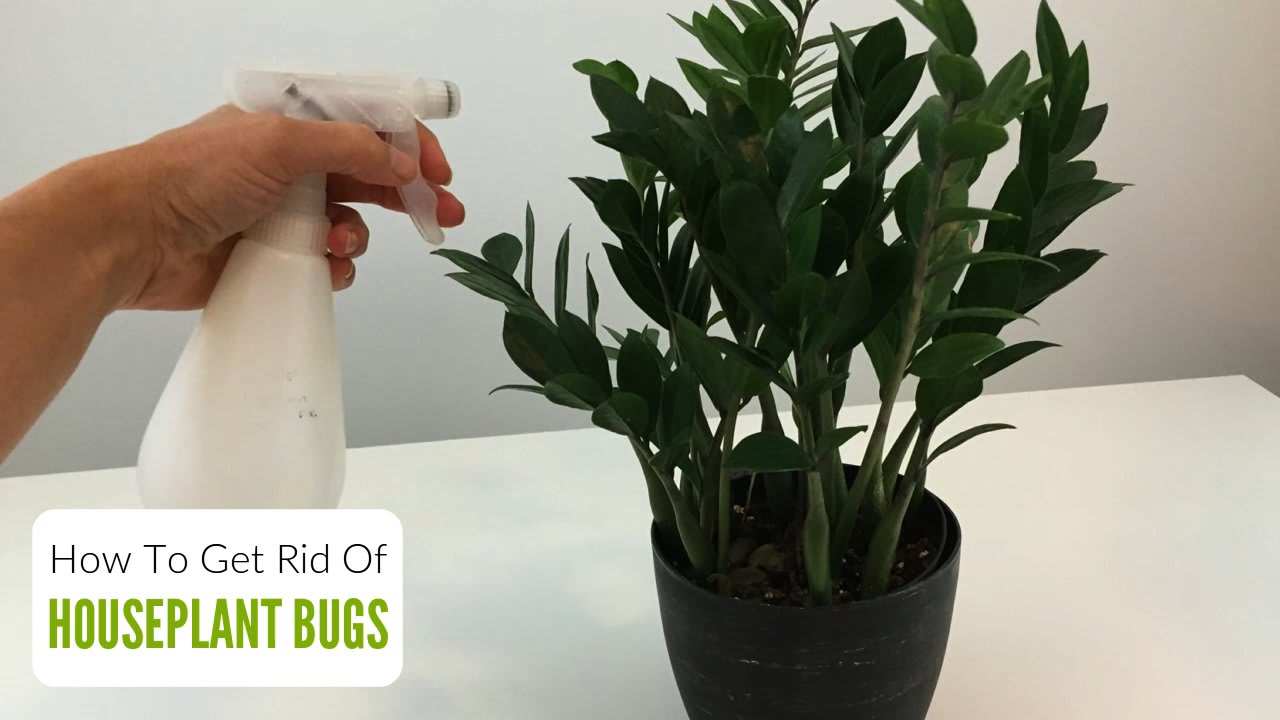No one likes bugs. They’re creepy, they’re crawly, and they definitely don’t belong in your house. But sometimes, despite your best efforts, bugs can make their way into your home – and onto your plants.
If you’ve found yourself with a bug problem, don’t worry – there are ways to get rid of them!
If your plants are anything like mine, they’re constantly under attack from pests! Here are a few tips to keep your plants bug free:
1. Inspect your plants regularly for signs of pests.
If you see any, isolate the plant from the rest of your collection and treat it immediately.
2. Keep your growing area clean and free of debris. This will help reduce the chances of pests getting a foothold in your garden.
3. Use organic pest control methods whenever possible. These are safer for both you and your plants, and are often just as effective as chemical treatments.
4. Be patient!
It can take some time to get rid of all the bugs, but it’s worth it to have a healthy, thriving garden.

Credit: getbusygardening.com
How Do I Get Rid of Bugs from My Houseplants?
Most of us have had the unfortunate experience of finding a bug in our houseplants. Whether it’s a gnat, aphid, or spider mite, these pests can quickly take over your plants and make them unhealthy. But don’t worry, there are a few things you can do to get rid of bugs from your houseplants!
First, try to identify what kind of bug is infesting your plant. This will help you choose the best treatment option. Common houseplant pests include aphids, mealybugs, whiteflies, and spider mites.
Once you’ve identified the pest, you can take steps to remove them from your plants.
One popular method is to simply wash the bugs off with water. Use a mild soap if necessary.
You can also use an insecticidal soap or horticultural oil. These products are safe for most plants and will kill the bugs on contact. Be sure to follow the directions on the label carefully.
If you have a serious infestation, you may need to resort to chemical pesticides. There are many different products available at your local garden center or home improvement store. Be sure to read the labels carefully and choose a product that is specifically designed for the type of bug you’re dealing with.
Follow all directions when using pesticides and take care not to damage your plants in the process!
With a little patience and effort, you can get rid of bugs from your houseplants and keep them healthy and happy!
What to Put on Plants to Keep Bugs off Naturally?
There are many ways to keep bugs off of plants naturally. Some common methods include using essential oils, diatomaceous earth, and neem oil.
Essential oils can be used as a natural insecticide.
Common essential oils that repel insects include lavender, citronella, eucalyptus, and peppermint. To use essential oils as an insecticide, simply add a few drops to a cotton ball or piece of cloth and wipe it on the plant leaves. You can also add a few drops of essential oil to water in a spray bottle and spritz the plant leaves with the mixture.
Diatomaceous earth is another effective natural insecticide. This powder is made from the fossilized remains of algae and is lethal to many types of insects when they come in contact with it. To use diatomaceous earth as an insecticide, simply sprinkle it around the base of the plant or on the leaves themselves.
Be sure to wear gloves when handling diatomaceous earth as it can be harmful to human skin if inhaled.
Neem oil is also an effective natural insecticide that works by disrupting the life cycle of insects such as aphids, whiteflies, and beetles. Neem oil can be purchased at most garden stores or online retailers.
To use neem oil as an insecticide, mix it with water in a ratio of 1:100 and spray it on the affected plants.
How to Get Rid of Bugs in Houseplants (4 Easy Steps)
How to Get Rid of Bugs on Indoor Plants Naturally
If you have indoor plants, chances are you’ve seen a bug or two crawling around on them. While most bugs are harmless, they can still be a nuisance. Luckily, there are several ways to get rid of bugs on indoor plants naturally.
One way to get rid of bugs is to mix together water and dish soap in a spray bottle. Then, simply spray the solution onto your plants. The dish soap will kill the bugs without harming the plant.
Another option is to make a homemade insecticide using neem oil. Simply mix together one teaspoon of neem oil with one cup of water and put it into a spray bottle. Again, spray this solution onto your plants and the bugs should die off within a day or two.
If you’re dealing with aphids, whiteflies, or mealybugs, try using horticultural oil. Mix together one part horticultural oil with ten parts water and put it into a spray bottle. Spray the solution onto the affected areas of your plant and those pesky pests should be gone in no time!
Finally, if all else fails, you can always bring in some natural predators to take care of the problem for you. Ladybugs love eating aphids, so releasing them near your plants is a great way to get rid of aphids naturally. You can also purchase predatory mites which will eat spider mites (another common type of indoor plant pest).
How to Get Rid of Bugs on Indoor Plants Soil
If you’re like most people, you probably have a few indoor plants that you take care of. And if you’re like most people, you probably also have to deal with the occasional bug infestation. Fortunately, there are a few things you can do to get rid of bugs on your indoor plants without resorting to harsh chemicals.
One of the best ways to get rid of bugs is to simply pick them off by hand. This may sound tedious, but it’s actually quite effective. You can also try using a vacuum cleaner with the hose attachment to suck up any bugs that are crawling around on your plant.
Another way to get rid of bugs is to introduce some natural predators into your home. Ladybugs and green lacewings are both great at getting rid of aphids and other small insects. You can purchase these insects online or at your local garden center.
Just release them near your plant and let them do their job!
Finally, if all else fails, you can always resort to using an insecticide. There are many organic options available that will kill bugs without harming your plants.
Just be sure to follow the directions carefully so that you don’t end up doing more harm than good.
Tiny Bugs in Houseplant Soil
If you have ever found tiny bugs in your houseplant soil, you are not alone. Many people find these little pests crawling around in their plants and wonder what they are and how to get rid of them.
These tiny bugs are called springtails, and they are actually quite beneficial for your plants.
They help aerate the soil and break down organic matter, which helps your plants grow healthy and strong. Springtails can become a problem, however, if they start to reproduce in large numbers. If you find that there are too many springtails in your plant’s soil, you can take some steps to reduce their population.
First, make sure that you are not overwatering your plants. Springtails thrive in moist environments, so if you keep the soil too wet, they will continue to multiply. Second, let the top layer of soil dry out completely between waterings.
This will create a less hospitable environment for the springtails and discourage them from reproducing. Finally, consider using a commercial pesticide designed specifically for springtails. Be sure to follow the directions on the label carefully so that you do not harm your plants or yourself!
Homemade Bug Spray for Indoor Plants
As the weather outside begins to warm up, so do the bugs. No one wants to share their home with creepy crawlers, but sometimes indoor plants can attract pests. Instead of reaching for chemical-laden bug sprays, try this natural and homemade solution!
What You Need:
1 cup water
1/2 cup white vinegar or apple cider vinegar
1 tsp. liquid dish soap (I like Dr. Bronner’s castile soap)
10 drops lavender essential oil OR 5 drops each of lavender and peppermint essential oils*
Instructions: Add all ingredients to a spray bottle and shake well to combine. Spray on affected areas as needed (test on a small area first to make sure your plant can handle it). The mixture will separate so just give it a good shake before using each time.
Conclusion
If your plants are infested with bugs, there are a few things you can do to get rid of them. First, try to identify the type of bug that is causing the problem. This will help you choose the best method for getting rid of them.
There are a few common houseplant pests, such as aphids, mealybugs, and whiteflies. You can usually find these bugs by looking for their telltale signs, such as webbing or small piles of excrement near the base of your plant. Once you’ve identified the pest, there are a few different methods you can use to get rid of it.
You can purchase an insecticide at your local gardening store, or make your own using household ingredients like dish soap or rubbing alcohol. You can also try using a natural predator like ladybugs or green lacewings to control the population of pests in your home.
